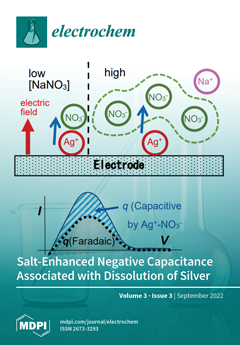Mass transport of different species plays a crucial role in electrochemical conversion of CO
due to the solubility limit of CO
in aqueous electrolytes. In this study, we investigate the transport of CO
and other ionic species through the electrolyte
[...] Read more.
Mass transport of different species plays a crucial role in electrochemical conversion of CO
due to the solubility limit of CO
in aqueous electrolytes. In this study, we investigate the transport of CO
and other ionic species through the electrolyte and the membrane, and its impact on the scale-up process of HCOO
/HCOOH formation. The mass transport of ions to the electrode and the membrane is modelled at constant current density. The mass transport limitations of CO
on the formation of HCOO
/HCOOH is investigated at different pressures ranges from 5–40 bar. The maximum achievable partial current density of formate/formic acid is increased with increasing CO
pressure. We use an ion exchange membrane model to understand the ion transport behaviour for both the monopolar and bipolar membranes. The cation exchange (CEM) and anion exchange membrane (AEM) model show that ion transport is limited by the electrolyte salt concentrations. For 0.1 M KHCO
, the AEM reaches the limiting current density more quickly than the CEM. For the BPM model, ion transport across the diffusion layer on either side of the BPM is also included to understand the concentration polarization across the BPM. The model revealed that the polarization losses across the bipolar membrane depend on the pH of the electrolyte used for the CO
reduction reaction (CO
2RR). The polarization loss on the anolyte side decreases with an increasing pH, while, on the cathode side, it increases with increasing catholyte pH. With this combined model for the electrode reactions and the membrane transport, we are able to account for the various factors influencing the polarization losses in the CO
electrolyzer. To complete the analysis, we simulated the full cell polarization curve and fitted with the experimental data.
Full article




